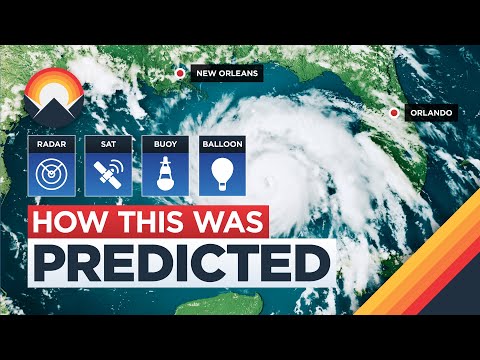How Weather Forecasting Works

It’s 4:55 AM on a March day at the National Weather Services’ Twin Cities forecast facility when the morning stillness is broken by the rattle of a garage door opening. As they do every single morning of every single day, a meteorologist working the station’s Public Service Desk is launching a helium and hydrogen-filled latex balloon connected to an expendable radiosonde by 80 feet of string. At the very same time, meteorologists from the other 91 NWS radiosonde stations across the US, along with hundreds from around the globe, are launching their own upper-air atmospheric soundings. In the next two hours, these balloons will climb up to 100,000 feet, or 30,000 meters into the atmosphere, drifting as far as 200 miles or 320 kilometers from their launch point while their payload, about the weight of a grapefruit, relays temperature, air pressure, and humidity data back to the station. The technology might be simple, but the readings from various altitudes captured every 12 hours are simply irreplaceable.
These data—transmitted by radio frequency then scrubbed for errors by the meteorologist that launched the balloon in the first place—will get compiled and plugged into impossibly complex models in the National Centers for Environmental Prediction, and then archived at the National Climate and Data Center. But that’s later. Right now, as the Minneapolis meteorologist follows their highly standardized routine one reading catches their eye. The barometer reads 1,017 millibars—a high pressure front’s developing.
For our meteorologist, an arctic cold front means a few more freezing commutes and balloon launches. For the rest of the US, it might not mean much, or it might present a problem—but that’s not a conclusion the data from a single balloon can possibly offer. To fulfill their task of telling the public what’s to come, the US’ National Weather Service is going to need far, far more data.
To start, the NWS operates 160 high-resolution Doppler weather radars, each dedicating seven seconds an hour to emitting quick bursts of energy, then the rest listening for its return to interpret what’s present in the sky—water or air. The multi-million dollar installations are spread out across the fifty states, Puerto Rico, Guam, and uniquely, at one US military base in Okinawa, Japan, and two others in South Korea—putting the American National Weather Service in the exceptional position of maintaining near-complete weather radar coverage over a foreign country. In the US itself, most metro areas are covered, and the deployment of the system was credited with increasing average tornado warning times from four to eleven minutes, but still, meaningful gaps exist.
While gaps over sparsely-populated western states are inconvenient obstacles to accurate forecasts, the NWS lacks visibility into some slivers of the area known as Tornado Alley—an area that relies on these radars to give them the notice needed to get into shelters when a tornado does form. With these NEXRAD radars now out of production and every existing one in use, there is little opportunity for improvement short of a costly system-wide upgrade, but for the most part, these 160 radars get the job done and form the foundation of the agency’s data-collection mission. But as groundbreakingly effective radar technology is, it’s a proxy for measurements actually taken in the sky. This is why the NWS goes through the effort to launch those hundreds of weather balloons daily, but of course, planes are already up there anyways. Not only that, but the typical commercial aircraft already has the instruments necessary to observe atmospheric conditions, so that’s why the World Meteorological Organization set up the Aircraft Meteorological Data Relay system. 43 airlines around the world—including Alaska, American, Delta, FedEx, Hawaiian, Southwest, United, and UPS—have agreed to collect meteorological data in-flight and transmit it to the WMO via satellite or VHF radio.
Meteorologists describe these data as crucial to the accuracy of forecasts, since such frequency of atmospheric data cannot be inexpensively obtained through any other means. In fact, forecasts globally became meaningfully less accurate at the start of the COVID pandemic due to the loss of much of these data as air travel took a downturn. But as important high-altitude data is to predicting what’s to come on the ground, the NWS still needs to know what’s happening on the ground right now. For that, there are 900 automated surface observation systems, again spread out across the entire country, primarily at airports.
These include a suite of sensors—temperature, air pressure, humidity, cloud coverage, and more—that automatically report data back to the NWS, and also automatically broadcast a radio frequency that pilots can use to gain valuable intel into conditions at their destination airport. Some observations, however, cannot be efficiently achieved through automated means. Some require the human touch. Precipitation—whether in rain, snow, or something in between—is largely measured by a hoard of unpaid civilian volunteers, donating their time to run 9,000 cooperative observer system sites across the country.
Each follows strict protocol to provide the NWS with a daily precipitation measurement for their local area, which is the primary manner through which forecasters validate their forecasts—if they see that precipitation is constantly under their prediction in a given area, they’ll adjust, and vice-versa. These data are also crucial for establishing long-term trends—it was this program, for example, that observed that average precipitation in the US has grown 7.8% since 1901 due to warming temperatures allowing the atmosphere to hold more water. A similar, even larger program exists called SKYWARN, where 350,000 trained volunteer weather spotters work with the NWS to act as their eyes on the ground.
These volunteers, many of which are amateur radio enthusiasts that use their skills to communicate observations regardless of external conditions, track severe weather to both allow the NWS to alert others of what’s to come and to help them validate their weather models and forecasts. But weather is global, and therefore in order to give Americans their forecast, the National Weather Service requires data from beyond the American states, territories, and few foreign radar sites. That’s why the World Meteorological Organization exists. This specialized United Nations agency has myriad responsibilities, but perhaps the most pivotal centers around ensuring different national forecasters can and do cooperate. As of a few years ago, data-sharing is mandatory among all WMO members, meaning the US’ NWS gets meteorological data from its foreign counterparts, and vice versa, regardless of their geopolitical status, thus improving the quality of forecasts for all. As one of the world’s preeminent meteorological organizations, the National Weather Service does, however, have some extra help in gathering data from the rest of the world: satellites.
For decades now, a rotating cast of satellites have held two geostationary positions called GOES-east and GOES-west, streaming down a deluge of imagery and meteorological data to the agency’s ground-station on Wallops Island, Virginia. GOES-east and west are currently operated by the GOES-16 and 17 satellites, respectively. In addition, the older GOES-15 satellite sits next to GOES-17 to provide redundant coverage, due to a reliability issue with 17, while GOES-14 sits powered-down in a storage orbit in case an issue with another requires a quick replacement—any gap in coverage from GOES east or west would impact forecast accuracy for hundreds of millions of Americans. Meanwhile, GOES-18 was launched in March, 2022 and will soon replace GOES-17 to operate as GOES-west. While these are focused on high-frequency, ongoing coverage of the US and its immediate surroundings, the agency also operates a non-geostationary satellite in a polar orbit to provide less-frequent yet still important data and imagery of the rest of the world.
A secondary function of these GOES satellites is to act as a means of communication for the most remote NWS observation stations on earth: buoys. Stationed hundreds or thousands of miles offshore, weather buoys provide a glimpse into areas of the earth entirely devoid of humans or civilization, but full of weather that could soon impact them. The network is run by NOAA’s National Data Buoy Center, and each transmits near real-time conditions from the Great Lakes, Gulf of Mexico, Atlantic, and Pacific, including giving life-saving warning of potential impending tsunamis, for example. More typically, however, they provide the same data land-based stations offer, but in an area useful for giving coastal regions a heads up of what’s to come. On the hour, buoys record temperature and pressure which is subsequently relayed by the GOES satellites to the mainland and the supercomputers vacuuming up all possible data to help project an accurate weather model.
The inclusion of these data may prove a good thing, too, as the same time that the weather balloon floating over Minnesota is picking up an in-bound high pressure front, this buoy, #42019 off the coast of Texas, is reading an above average air temperature and a below average air pressure. For local forecasters, buoy station 42019, along with other readings, hint at a developing low-pressure front—some rain might be arriving along the gulf here soon. But as weather models render—taking into account both an arctic front descending across the midwest and a warm, moisture-laden front developing across the gulf, a little rain might soon be the least of the NWS’s worries. Weather develops at very different scales and to very different consequences. To protect the individual, the thousands, and the millions, the NWS has to predict weather developments at varying scales.
These predictions of all size and shape all largely emanate from here, the National Centers for Environmental Prediction’s Weather Prediction Center, where data from balloons, buoys, planes, and satellites the world over pours into various weather models. While the NWS produces a bevy of different models, they broadly all work the same. In each, numbers representing observed environmental conditions are plugged into a myriad of equations, the results of which, once overlaid on a map, offer both an approximate snapshot of the current atmospheric conditions and a simulated future that predicts how weather patterns will develop and move. While the same data, the same math, and the same laws of physics undergird all weather modeling, it’s a model’s resolution and range that differentiates one from the next.
The High Resolution Rapid Refresh model, for example, with its 2 mile, 3 kilometer resolution; its real-time visualizations; and its every-hour updating, offers unmatched detail and accuracy on the development of rapid-moving thunderstorms over the next hour, providing meteorologists more confidence in offering severe weather warnings. What it can’t do is zoom out temporally or spatially to forecast nationwide developments even hours into the future—it’s scope is too focused. It can tell you to evacuate now, but can’t help you decide to bring a rain jacket tomorrow. To help inform such important decisions between rain jackets or sunscreen, meteorologists use the North American Mesoscale model, which offers lower resolution than the HRRR but identifies patterns then forecasts their paths out to 61 hours. For an even broader picture, the NWS relies on the Global Forecast System which again takes a broader view than the NAW but is able to interpret atmospheric patterns and weather developments of global scale and to predict out to 10 days in the future—critical in tracking the long development of hurricanes, for instance.
Together, these models are incredibly powerful predictive tools. Running all these models, in turn, requires incredibly powerful computers. What makes all these models possible are two of the largest supercomputers in the US. In the wake of the NWS’s Global Forecast System failing to identify the dangerous potential of Hurricane Sandy, Congress green-lit increased funding for NOAA. The result was the 2016 announcement that NOAA had increased its computing power 10-fold with the introduction of two supercomputers in Reston, Virginia and Orlando, Florida. The $45 million addition put the 18th fastest computer in the US in the hands of NOAA which effectively evened the playing field between the NWS and its European counterpart.
Doubling down on the modernization effort, NOAA again invested in its supercomputers in 2018, adding 60% more storage and more than doubling their computing capacity—moves which made room for updates and improvements to its models, from the HRRR to the GFS. Importantly, and further justifying such investment, these super computers are not only tasked to run and re-run and re-run atmospheric models all day, every day, they’re also tasked with creating ensemble models—effectively running the same models time and time again with the parameters slightly changed to reflect the random chance of real world weather, and to therefore give forecasters an idea of the degree of uncertainty for a given prediction. If the forecast holds up despite the random chance thrown in by the ensemble model, it’s more certain, and vice versa.
Together, these various models and the supercomputers that run them nonstop are immensely complex and extremely expensive. In the past they have proved incredibly valuable when extreme weather arises, and in the future, as far-flung, disparate signs of storms quietly develop, they’ll prove critical to meteorologists again. Hours after the launch of a weather balloon in Minnesota and a buoy’s upload off the coast of Texas on an early March day they’re proving their worth again as GFS forecasts, and then ensemble GFS forecasts are beginning to project with higher confidence that a storm of significant destructive potential may be brewing. In the days prior, as millibars dropped over Texas, GFS models had identified the early stages of what meteorologists call a Gulf Low. Now with buoys proving such predictions correct, and with the concurrent development of a dropping cold front, they can now predict its direction and potential severity. While this Gulf Low seems to be mirroring historical patterns in that it too is primed to move a mountain of moisture out of the Gulf of Mexico, this particular storm, thanks to the deepening cold front and a U-shaped gulf stream, doesn’t look like it will track along the western edge of the Appalachians, but rather, through some of the most densely populated regions of the American east coast.
According to GFS forecasting, snow, and a lot of it, is headed northeast. Of course, forecasts are meaningless by themselves. To avoid the disaster of an unprepared populace in the firing line of an impending winter storm—plows still in the parking lot, stores without extra stock, kids still in school, commuters on the road at the wrong time—the National Weather Service has to actually communicate what’s to come. To achieve this, the agency has 122 weather forecast offices distributed across the fifty states, Puerto Rico, and Guam, each responsible for a dedicated zone of the country.
The couple dozen staff in each work 24/7 to interpret models and issue forecasts for their surrounding region. Perhaps most importantly, though, they monitor and issue alerts for the most localized, and often most dangerous threats—severe thunderstorm, flash flood, tornado warnings and more all come from local WFOs. The on-the-ground presence also allows WFOs to tailor their activities to what’s necessary for the people they serve. The Fairbanks, Alaska WFO issues a daily climbing weather forecast for nearby Denali—America’s tallest mountain. The Dodge City, Kansas WFO, surrounded by hundreds of miles of wheat fields, reports daily soil temperatures so farmers can optimize their yields. The Grand Junction, Colorado WFO monitors and reports fire weather conditions—alerting the wildfire-prone area it’s responsible for to the daily risk of one starting and spreading, and therefore informing campfire bans, electric grid shutdowns, and more.
Like most WFOs in fire-prone areas, the Grand Junction office also staffs an Incident Meteorologist who is prepared to quickly deploy to the field and embed in a wildfire camp to issue highly-specific forecasts used by aerial firefighting pilots, hot shot crews, and other firefighters to safely approach and attack the burn. Finally, the local WFOs are responsible for many of the NWS’ on-the-ground operations, from maintaining doppler radars and automated surface observation stations to running the local NWS Twitter account and far, far more. Ultimately, though, certain weather is just too big or otherworldly to be handled by small, local WFOs. For that, there are the national offices. Some are straightforward.
Rivers, for example, run for hundreds or thousands of miles through countless WFO zones, so there’s an additional system of thirteen river forecast centers that split up the lower 48 and Alaska more or less based on watershed, issuing forecasts for their rivers’ flows and, most importantly, their flood risk. Perhaps the best-known of these national offices is the National Hurricane Center, based in a bunker-like building in Miami, Florida that’s designed and certified to survive and operate through a category five hurricane—the most severe level. They have the stressful task of predicting the paths and intensities of hurricanes.
If they get it right and people prepare, lives will be saved. If they miss the forecast, lives will be lost—and they potentially do this all while a hurricane passes directly over them. For this reason, the system is structured so the National Weather Prediction Center in College Park, Maryland is prepared to take over responsibilities in an instant if the Miami center GOES offline during a storm, while there’s also an additional office in Honolulu, Hawaii that staffs up if a comparatively rare central Pacific hurricane forms.
Most uniquely, the National Weather Service is also responsible for forecasting the weather not only beyond the borders of the US, but beyond the borders of this world. The NWS’ Space Weather Prediction Center in Boulder, Colorado takes in data from the GOES satellites and terrestrial sensors to report current and forecast future solar radiation and other space weather. This isn’t just for the novelty, as high solar radiation activity, for example, can impact the human world.
High frequency radio gets disrupted during solar flares, so commercial aircraft can’t fly routes over the poles where they rely on it to talk to Air Traffic control if the center has forecasted high levels of radiation—and that’s just the very start of issues solar flares can cause. Ultimately, though, the totality of the National Weather Service’s work—the thousands of hourly observations from across the world and beyond, the full processing might of two incredible supercomputers, the collective efforts of thousands of highly-trained individuals—all distills down to this: a couple-megabyte XML data feed updated every few minutes. Generally, people don’t get the weather directly from the National Weather Service—they get it from the weather app on their phone, the TV meteorologist, or whatever’s most convenient for them. Nearly every source of weather information in the US relies on the work of the National Weather Service, even if it’s repacked and rebranded, so the NWS works to make these data abundantly accessible to those that get it to the end-user.
These XML data-feeds are a major source, providing a structured set of current conditions and forecasts that can be quickly adapted and interpreted by software, and everyone, from individuals to commercial companies, is legally allowed to use these data since, as a production of the US-government, it is not copyrighted and does not require a license. Of course, the times when weather information is most important are often also the times when communications are most difficult—the internet and TV might not be accessible when it really matters. Therefore, some 95% of the US population is within range of a NOAA Weather Radio station which automatically broadcast a 24/7 feed of conditions and forecasts.
As a last-resort, the National Weather service also runs the Emergency Managers Weather Information Network, which uses their GOES satellites to broadcast a data-feed down to earth that, uniquely, is accessible to anyone with a compatible satellite receiver. This data-feed, available at 1694.1 megahertz, includes all the highlights of conditions and forecasts for sites across the US, and even includes these visual forecasts, satellite imagery, and other images for onward use—allowing TV stations, emergency managers, and others to access this crucial information regardless of the condition of the world around them. In sum, this is how the National Weather Service tells the east coast a snowstorm is coming: all it requires is a couple of satellites and supercomputers; hundreds of radars, observation stations, buoys, weather balloons, aircraft, and weather forecast offices; and thousands upon thousands of dedicated staff and volunteers.
Rather than do the normal style of ad—since, given the fact that you’re watching this, it hasn’t convinced you yet—this time I’m going to count down the top ten of the many reasons why you should sign up for the Nebula/CuriosityStream bundle deal. 10: You can watch this and all of our regular videos without ads or sponsorships. 9: You can watch other channels like Real Life Lore, Not Just Bikes, Mustard, and far more also ad and sponsorship free. 8: You can watch all of these different big-budget Originals that we’ve made—we put a ton of work into each, and I think they’re all great. 7: You can watch every episode from our new channel, Jet Lag: The Game, a full week early. 6: You can watch all sorts of Originals by other independent creators—I’d recommend Patrick Willems’ Night of the Coconut, which is a feature-length multiverse film about a genocidal coconut.
It’s tough to explain but it’s so much fun and so well made and even includes a cameo by me. 5: You can discover other fantastic channels, as Nebula only includes a curated group of high-quality, thoughtful creators. One that I love in a very different genre is Berm Peak, where Seth brings his audience along to his unbelievable mountain bike trail-building projects in a way that even people with absolutely no affinity for bikes enjoy.
4: You can watch the smart, thoughtful content you clearly enjoy without an algorithm surfacing other clickbaity videos to pull your attention away—it’s just you and the videos, without a platform designed to suck you in for as long as possible. 3: By watching through Nebula, you support all these independent creators, and assure they make a stable income that helps them keep creating everything you love watching. 2: By signing up through our link, CuriosityStream.com/Wendover, you’ll get the bundle deal with CuriosityStream included, meaning you also get access to their fantastic catalog of top-notch nonfiction shows and documentaries, like Container Ship XXL—about how the largest container ship in existence was designed and built. And number one: All of this costs just $14.79 for a year—that’s less than you probably
pay for a month of the other streaming services you use, and this is two of them that you’ll actually use. So, click the button on-screen or head to CuriosityStream.com/Wendover to sign up for the bundle deal, and thanks in advance for your support.
2022-07-02 16:02


